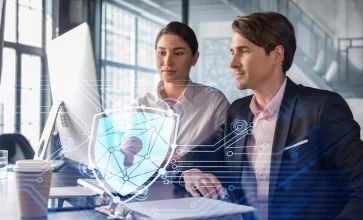How To Leverage Visitor Management Systems For Enhanced Security
In the quest for robust security measures, organizations are increasingly turning to technological solutions that streamline operations and bolster defenses. Visitor management systems (VMS) have emerged as a critical component in securing premises by monitoring and managing guest access. These systems not only enhance operational efficiency but also provide a verifiable way to track those who enter and leave the facility. Sophisticated VMS can serve as the frontline in preventing unauthorized access and maintaining safety protocols. Keep reading to uncover how these systems can transform your security landscape.
Understanding Visitor Management Systems And Their Role In Security
A visitor management system is a digital platform that replaces traditional sign-in sheets, offering a more secure and efficient method of tracking guest activity. With features such as ID scanning, custom check-in workflows, and real-time tracking, VMS provides a comprehensive view of visitor traffic. This enables organizations to quickly identify who is on the premises, why they are there, and whom they are visiting, thereby establishing a first layer of security and accountability.
Fundamental to their role in enhancing security is the ability of VMS to maintain detailed records of visitor data. This data is invaluable during emergencies or security audits, as it allows for quick access to historical visitation information. Moreover, an iPad visitor management system can alert staff to potential security breaches by flagging individuals who have been barred from entry or signaling when someone fails to check out properly.
VMS is particularly effective in reducing the risks associated with human error. By automating the check-in process, it ensures visitor information is captured accurately and consistently. Pre-registration features further enhance security by allowing for the vetting of guests before they arrive, ensuring a controlled and monitored entry into the facility.
The privacy of visitors and the security of their data are additional considerations that VMS addresses. Advanced systems encrypt visitor information and ensure compliance with global privacy regulations, making them an indispensable tool for businesses dealing with sensitive information or operating within regulated industries.
Why Would You Need A Visitor Management Software?
An effective VMS is tailored to serve the needs of the organizations that host different events. They are indeed helpful in managing the entire event so that it eliminates the hassles of the event. Forget about events; you must optimize the visitor’s management systems effectively to understand daily tracking better. However, a pertinent question that keeps afloat in different corners is about the efficacy of visitor management software.
Visitor Management Systems Guide The Receptionists
The role of the receptionists of a company contributes a lot to the development of an organization. Therefore, it is quite common for organizations to take steps to help them in their daily work. Usually, the receptionists take notes and are responsible for entering and jotting down every detail of it. Visitor management systems are said to be highly beneficial to the help desk department. It ensures that both you and your receptionists are happy.
Office Security
The top challenges before the visitor management software include information security, visitor privacy, planning of emergency evacuation, regulations, and compliance. The visitor management system plays an important function by collecting and storing the relevant data on behalf of the organization. Then, ensure that the data is thoroughly secure.
Brand Image Challenges
Organizations, irrespective of size, especially small businesses, try their best to understand and create their own brand image and sustain it. With a thorough discipline using the visitor’s management systems, they build an image of trust.
Key Features Of Visitor Management Systems That Boost Security
A hallmark of effective VMS is its integrated approach to security. By incorporating features such as biometric verification, photo capture, and digital signatures, they significantly raise the barriers to unauthorized access. These authentication steps serve not only as a deterrent to ill-intended visitors but also as a reliable method for identity verification.
Another key feature is the ability to issue visitor badges, which can be color-coded or feature varying levels of access. This visible identifier allows staff to readily ascertain a guest’s legitimacy and their permitted areas within the site. Badging systems are typically customizable, providing flexibility to meet specific organizational security requirements.
Real-time monitoring is a critical aspect of VMS that enhances situational awareness. Security personnel can track visitor movements within the premises, receive alerts for irregular check-ins or check-outs, and be notified of any attempts to access restricted areas. Moreover, integration with security systems can provide video footage of visitors for additional scrutiny or investigative purposes. Video footage can be used for school visitor management systems or retail settings.
Integrating Visitor Management With Other Security Measures
The true potential of VMS emerges when integrated with a broader security framework. For instance, connecting VMS with access control systems ensures doors and barriers respond appropriately to authorized visitor badges. This interconnectedness forms a more impenetrable security barrier, coordinating multiple checkpoints seamlessly.
Synchronization with emergency communication systems also plays a pivotal role in response to incidents. In the event of an evacuation or lockdown, VMS can be utilized to account for all visitors, facilitating a swift and safe egress. Moreover, integrating with HR systems can help coordinate employee and visitor presences, automating notifications when hosts need to meet their guests.
To extend security measures beyond the immediate premises, cloud-based systems offer remote access and control. Security managers can monitor visitor activity from any location, ensuring uninterrupted oversight. This agility is vital in responding to dynamic security challenges and maintaining continuity in visitor monitoring.
Collaboration with IT departments is essential when integrating VMS into the larger security infrastructure. Their expertise in network security can prevent cyber breaches that could compromise both visitor and organizational data. Ensuring secure data transfer and storage is essential in maintaining the integrity of the visitor management process.
Overall, effectively leveraging visitor management solutions can dramatically enhance organizational security, providing a safer environment for both visitors and staff. By following best practices for implementation and integrating with existing security measures, these systems prove to be invaluable assets in the quest to create secure and efficient entry processes.
Also Read ?






















